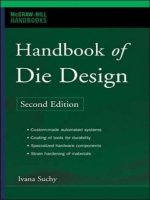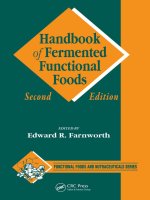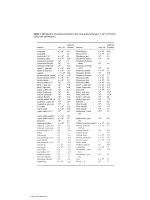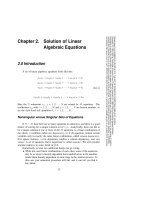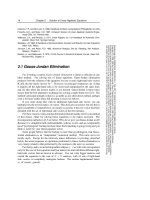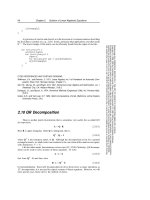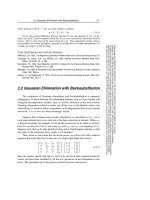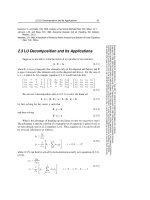handbook of linear algebra
Bạn đang xem bản rút gọn của tài liệu. Xem và tải ngay bản đầy đủ của tài liệu tại đây (14.4 MB, 1,402 trang )
Chapman & Hall/CRC
Taylor & Francis Group
6000 Broken Sound Parkway NW, Suite 300
Boca Raton, FL 33487-2742
© 2007 by Taylor & Francis Group, LLC
Chapman & Hall/CRC is an imprint of Taylor & Francis Group, an Informa business
No claim to original U.S. Government works
Printed in the United States of America on acid-free paper
10 9 8 7 6 5 4 3 2 1
International Standard Book Number-10: 1-58488-510-6 (Hardcover)
International Standard Book Number-13: 978-1-58488-510-8 (Hardcover)
is book contains information obtained from authentic and highly regarded sources. Reprinted material is quoted
with permission, and sources are indicated. A wide variety of references are listed. Reasonable efforts have been made to
publish reliable data and information, but the author and the publisher cannot assume responsibility for the validity of
all materials or for the consequences of their use.
No part of this book may be reprinted, reproduced, transmitted, or utilized in any form by any electronic, mechanical, or
other means, now known or hereafter invented, including photocopying, microfilming, and recording, or in any informa-
tion storage or retrieval system, without written permission from the publishers.
For permission to photocopy or use material electronically from this work, please access www.copyright.com (http://
www.copyright.com/) or contact the Copyright Clearance Center, Inc. (CCC) 222 Rosewood Drive, Danvers, MA 01923,
978-750-8400. CCC is a not-for-profit organization that provides licenses and registration for a variety of users. For orga-
nizations that have been granted a photocopy license by the CCC, a separate system of payment has been arranged.
Trademark Notice: Product or corporate names may be trademarks or registered trademarks, and are used only for
identification and explanation without intent to infringe.
Visit the Taylor & Francis Web site at
and the CRC Press Web site at
Dedication
Idedicate this book to my husband, Mark Hunacek, with gratitude both for his support
throughout this project and for our wonderful life together.
vii
Acknowledgments
Iwould liketo thank ExecutiveEditor Bob Stern of Taylor & Francis Group,whoenvisioned this project and
whose enthusiasm and support has helped carry it to completion. I also want to thank Yolanda Croasdale,
Suzanne Lassandro, Jim McGovern, Jessica Vakili and Mimi Williams, for their expert guidance of this
book through the production process.
Iwould like to thank the many authors whose work appears in this volume for the contributions of
their time and expertise to this project, and for their patience with the revisions necessary to produce a
unified whole from many parts.
Without the help of the associate editors, Richard Brualdi, Anne Greenbaum, and Roy Mathias, this
book would not have been possible. They gave freelyoftheir time, expertise, friendship, and moral support,
and I cannot thank them enough.
I thank Iowa State University for providing a collegial and supportive environment in which to work,
not only during the preparation of this book, but for more than 25 years.
Leslie Hogben
ix
The Editor
Leslie Hogben, Ph.D., is a professor of mathematics at Iowa State University. She received her B.A. from
Swarthmore College in 1974 and her Ph.D. in 1978 from Yale University under the direction of Nathan
Jacobson. Although originally working in nonassociative algebra, she changed her focus to linear algebra
in the mid-1990s.
Dr. Hogben is a frequent organizer of meetings, workshops, and special sessions in combinatorial linear
algebra, including the workshop, “Spectra of Families of Matrices Described by Graphs, Digraphs, andSign
Patterns,”hostedbyAmerican InstituteofMathematicsin2006 andthe TopicsinLinear AlgebraConference
hosted by Iowa State University in 2002. She is the Assistant Secretary/Treasurer of the International Linear
Algebra Society.
An active researcher herself, Dr. Hogben particularly enjoys introducing graduate and undergraduate
students to mathematical research. She has three current or former doctoral students and nine master’s
students, and has worked with many additional graduate students in the Iowa State University Combinato-
rial Matrix Theory ResearchGroup,which shefounded.Dr.Hogbenisthe co-directorof theNSF-sponsored
REU “Mathematics and Computing Research Experiences for Undergraduates at Iowa State University”
and has served as a research mentor to ten undergraduates.
xi
Contributors
Marianne Akian
INRIA, France
Zhaojun Bai
University of California-Davis
Ravindra Bapat
Indian Statistical Institute
Francesco Barioli
University of
Te nnessee-Chattanooga
Wa yne Barrett
Brigham Young University, UT
Christopher Beattie
Virginia Polytechnic Institute
and State University
Peter Benner
Te c hnische Universit
¨
at
Chemnitz, Germany
Dario A. Bini
Universit
`
adiPisa, Italy
Alberto Borobia
U. N. E. D, Spain
Murray R. Bremner
University of Saskatchewan,
Canada
Richard A. Brualdi
University of
Wisconsin-Madison
Ralph Byers
University of Kansas
Peter J.Cameron
Queen Mary, University of
London, England
Alan Kaylor Cline
University of Texas
Fritz Colonius
Universit
¨
at Augsburg, Germany
Robert M. Corless
University of Western Ontario,
Canada
Biswa Nath Datta
Northern Illinois University
Jane Day
San Jose State University, CA
Luz M. DeAlba
Drake University, IA
James Demmel
University of
California-Berkeley
Inderjit S. Dhillon
University of Texas
Zijian Diao
Ohio University Eastern
J. A. Dias da Silva
Universidade de Lisboa,
Portugal
Jack Dongarra
University of Tennessee and
Oakridge National Laboratory
Zlatko Drma
ˇ
c
University of Zagreb, Croatia
Victor Eijkhout
University of Tennessee
Mark Embree
Rice University, TX
Shaun M. Fallat
University of Regina, Canada
Miroslav Fiedler
Academy of Sciences of the
Czech Republic
Roland W. Freund
University of California-Davis
Shmuel Friedland
University of Illinois-Chicago
St
´
ephane Gaubert
INRIA, France
Anne Greenbaum
University of Washington
Willem H. Haemers
Tilburg University, Netherlands
xiii
Frank J. Hall
Georgia State University
Lixing Han
University of Michigan-Flint
PerChristian Hansen
Te c hnical University of
Denmark
Daniel Hershkowitz
Te c hnion, Israel
Nicholas J. Higham
University of Manchester,
England
Leslie Hogben
Iowa State University
Randall Holmes
Auburn University, AL
Kenneth Howell
University of Alabama in
Huntsville
Mark Hunacek
Iowa State University, Ames
David J. Jeffrey
University of Western Ontario,
Canada
Charles R. Johnson
College of William and Mary, VA
Steve Kirkland
University of Regina, Canada
Wolfgang Kliemann
Iowa State University
Julien Langou
University of Tennessee
AmyN.Langville
The College of Charleston, SC
Ant
´
onio Leal Duarte
Universidade de Coimbra,
Portugal
Steven J. Leon
University of
Massachusetts-Dartmouth
Chi-Kwong Li
College of William and Mary,
VA
Ren-Cang Li
University of Texas-Arlington
Zhongshan Li
Georgia State University
Raphael Loewy
Te c hnion, Israel
Armando Machado
Universidade de Lisboa,
Portugal
RoyMathias
University of Birmingham,
England
Volker Mehrmann
Te c hnical University Berlin,
Germany
Beatrice Meini
Universit
`
adiPisa, Italy
Carl D. Meyer
NorthCarolina State University
Mark Mills
Central College, Iowa
Lucia I. Murakami
Universidade de S
˜
ao Paulo,
Brazil
Michael G. Neubauer
California State
University-Northridge
Michael Neumann
University of Connecticut
Esmond G. Ng
Lawrence Berkeley National
Laboratory, CA
Michael Ng
Hong Kong Baptist University
Hans Bruun Nielsen
Te c hnical University of
Denmark
Simo Puntanen
University of Tampere, Finland
Robert Reams
Virginia Commonwealth
University
Joachim Rosenthal
University of Zurich,
Switzerland
Uriel G. Rothblum
Te c hnion, Israel
Heikki Ruskeep
¨
a
¨
a
University of Turku, Finland
Carlos M. Saiago
Universidade Nova de Lisboa,
Portugal
Lorenzo Sadun
University of Texas
Hans Schneider
University of
Wisconsin-Madison
George A. F. Seber
University of Auckland, NZ
Peter
ˇ
Semrl
University of Ljubljana,
Slovenia
Bryan L. Shader
University of Wyoming
Helene Shapiro
Swarthmore College, PA
Ivan P. Shestakov
Universidad de S
˜
ao Paulo, Brazil
Ivan Slapni
ˇ
car
University of Spilt, Croatia
xiv
Danny C. Sorensen
Rice University, TX
Michael Stewart
Georgia State University
Jeffrey L. Stuart
Pacific Lutheran University, WA
George P. H. Styan
McGill University, Canada
Tatjana Stykel
Te c hnical University Berlin,
Germany
Bit-Shun Tam
Tamkang University, Taiwan
T. Y. Tam
Auburn University, AL
Michael Tsatsomeros
Washington State University
Leonid N. Vaserstein
Pennsylvania State University
AmyWangsness
Fitchburg State College, MA
IanM.Wanless
Monash University, Australia
JennyWang
University of California-Davis
David S. Watkins
Washington State University
William Watkins
California State
University-Northridge
Paul Weiner
St. Mary’s University of
Minnesota
Robert Wilson
Rutgers University, NJ
Henry Wolkowicz
University of Waterloo, Canada
Zhijun Wu
Iowa State University
xv
Contents
Preliminaries
P-1
Part I Linear Algebra
Basic Linear Algebra
1 Ve ctors, Matrices and Systems of Linear Equations
Jane Day
1-1
2 Linear Independence, Span, and Bases
Mark Mills
2-1
3 Linear Transformations
Francesco Barioli
3-1
4 Determinants and Eigenvalues
Luz M.DeAlba
4-1
5 Inner Product Spaces, Orthogonal Projection, Least Squares
and Singular Value Decomposition
Lixing Han and Michael Neumann
5-1
Matrices with Special Properties
6 Canonical Forms
Leslie Hogben
6-1
7 Unitary Similarity, Normal Matrices and Spectral Theory
Helene Shapiro
7-1
8 Hermitian and Positive Definite Matrices
Wayne Barrett
8-1
9 Nonnegative and Stochastic Matrices
Uriel G.Rothblum
9-1
xvii
10 Partitioned Matrices
Robert Reams
10-1
Advanced Linear Algebra
11 Functions of Matrices
Nicholas J. Higham
11-1
12
Quadratic, Bilinear and Sesquilinear Forms
Raphael Loewy
12-1
13 Multilinear Algebra
J. A. Dias da Silva and Armando Machado
13-1
14
Matrix Equalities and Inequalities
Michael Tsatsomeros
14-1
15 Matrix Perturbation Theory
Ren-Cang Li
15-1
16 Pseudospectra
Mark Embree
16-1
17 Singular Values and Singular Value Inequalities
RoyMathias
17-1
18 Numerical Range
Chi-Kwong Li
18-1
19 Matrix Stability and Inertia
Daniel Hershkowitz
19-1
Topics in Advanced Linear Algebra
20 Inverse Eigenvalue Problems
Alberto Borobia
20-1
21 Totally Positive and Totally Nonnegative Matrices
Shaun M. Fallat
21-1
22 Linear Preserver Problems
Peter
ˇ
Semrl
22-1
23 Matrices over Integral Domains
Shmuel Friedland
23-1
24 Similarity of Families of Matrices
Shmuel Friedland
24-1
25 Max-Plus Algebra
Marianne Akian, Ravindra Bapat, St´ephane Gaubert
25-1
xviii
26 Matrices Leaving a Cone Invariant
Bit-Shun Tam and Hans Schneider
26-1
Part II Combinatorial Matrix Theory and Graphs
Matrices and Graphs
27 Combinatorial Matrix Theory
Richard A. Brualdi
27-1
28 Matrices and Graphs
Willem H. Haemers
28-1
29 Digraphs and Matrices
Jeffrey L. Stuart
29-1
30 Bipartite Graphs and Matrices
Bryan L. Shader
30-1
Topics in Combinatorial Matrix Theory
31 Permanents
IanM.Wanless
31-1
32 D-Optimal Designs
Michael G. Neubauer and William Watkins
32-1
33 Sign Pattern Matrices
Frank J. Hall and Zhongshan Li
33-1
34 Multiplicity Lists for the Eigenvalues of Symmetric Matrices
with a Given Graph
Charles R. Johnson, Ant´onio Leal Duarte, and Carlos M. Saiago
34-1
35 Matrix Completion Problems
Leslie Hogben and Amy Wangsness
35-1
36 Algebraic Connectivity
SteveKirkland
36-1
Part III Numerical Methods
Numerical Methods for Linear Systems
37 Ve ctor and Matrix Norms, Error Analysis, Efficiency and Stability
Ralph Byers and Biswa Nath Datta
37-1
38 Matrix Factorizations, and Direct Solution of Linear Systems
Christopher Beattie
38-1
xix
39 Least Squares Solution of Linear Systems
Per Christian Hansen and Hans Bruun Nielsen
39-1
40 Sparse Matrix Methods
Esmond G. Ng
40-1
41 Iterative Solution Methods for Linear Systems
Anne Greenbaum
41-1
Numerical Methods for Eigenvalues
42 Symmetric Matrix Eigenvalue Techniques
Ivan Slapniˇcar
42-1
43 Unsymmetric Matrix Eigenvalue Techniques
DavidS.Watkins
43-1
44 The Implicitly Restarted Arnoldi Method
D. C. Sorensen
44-1
45 Computation of the Singular Value Deconposition
Alan Kaylor Cline and Inderjit S. Dhillon
45-1
46 Computing Eigenvalues and Singular Values to High Relative Accuracy
Zlatko Drmaˇc
46-1
Computational Linear Algebra
47 Fast Matrix Multiplication
DarioA.Bini
47-1
48 Structured Matrix Computations
Michael Ng
48-1
49
Large-Scale Matrix Computations
Roland W. Freund
49-1
Part IV Applications
Applications to Optimization
50 Linear Programming
Leonid N. Vaserstein
50-1
51
Semidefinite Programming
Henry Wolkowicz
51-1
xx
Applications to Probability and Statistics
52 Random Vectors and Linear Statistical Models
Simo Puntanen and George P. H. Styan
52-1
53 Multivariate Statistical Analysis
Simo Puntanen, George A. F. Seber, and George P. H. Styan
53-1
54 Markov Chains
Beatrice Meini
54-1
Applications to Analysis
55 Differential Equations and Stability
Volker Mehrmann and Tatjana Stykel
55-1
56 Dynamical Systems and Linear Algebra
Fritz Colonius and Wolfgang Kliemann
56-1
57 Control Theory
Peter Benner
57-1
58 Fourier Analysis
Kenneth Howell
58-1
Applications to Physical and Biological Sciences
59 Linear Algebra and Mathematical Physics
Lorenzo Sadun
59-1
60 Linear Algebra in Biomolecular Modeling
Zhijun Wu
60-1
Applications to Computer Science
61 Coding Theory
Joachim Rosenthal and Paul Weiner
61-1
62 Quantum Computation
Zijian Diao
62-1
63 Information Retrieval and Web Search
AmyLangville and Carl Meyer
63-1
64 Signal Processing
Michael Stewart
64-1
Applications to Geometry
65 Geometry
Mark Hunacek
65-1
xxi
66 Some Applications of Matrices and Graphs in Euclidean Geometry
Miroslav Fiedler
66-1
Applications to Algebra
67 Matrix Groups
Peter J. Cameron
67-1
68 Group Representations
Randall Holmes and T. Y. Tam
68-1
69
Nonassociative Algebras
Murray R. Bremner, Lucia I. Muakami and Ivan P. Shestakov
69-1
70 Lie Algebras
Robert Wilson
70-1
Part V Computational Software
Interactive Software for Linear Algebra
71 MATLAB
Steven J. Leon
71-1
72 Linear Algebra in Maple
DavidJ.Jeffrey and Robert M. Corless
72-1
73
Mathematica
Heikki Ruskeep¨a¨a
73-1
Packages of Subroutines for Linear Algebra
74 BLAS
Jack Dongarra, Victor Eijkhout, and Julien Langou
74-1
75 LAPACK
Zhaojun Bai, James Demmel, Jack Dongarra, Julien Langou, and Jenny Wang
75-1
76
UseofARPACK and EIGS
D. C. Sorensen
76-1
77 Summary of Software for Linear Algebra Freely Available on the Web
Jack Dongarra, Victor Eijkhout, and Julien Langou
77-1
Glossary G-1
Notation Index N-1
Index I-1
xxii
Preface
It is no exaggeration to say that linear algebra is a subject of central importance in both mathematics and a
variety of other disciplines. It is used by virtually all mathematicians and by statisticians, physicists, biologists,
computer scientists, engineers, and social scientists. Just as the basic idea of first semester differential calculus
(approximating the graph of a function by its tangent line) provides information about the function, the
process of linearization often allows difficult problems to be approximated by more manageable linear ones.
This can provide insight into, and, thanks to ever-more-powerful computers, approximate solutions of the
original problem. For this reason, people working in all the disciplines referred to above should find the
Handbook of Linear Algebra an invaluable resource.
The Handbook is the first resource that presents complete coverage of linear algebra, combinatorial lin-
ear algebra, and numerical linear algebra, combined with extensive applications to a variety of fields and
information on software packages for linear algebra in an easy to use handbook format.
Content
The Handbook covers the major topics of linear algebra at both the graduate and undergraduate level as well
as its offshoots (numerical linear algebra and combinatorial linear algebra), its applications, and software
packages for linear algebra computations. The Handbook takes the reader from the very elementary aspects
of the subject to the frontiers of current research, and its format (consisting of a number of independent
chapters each organized in the same standard way) should make this book accessible to readers with divergent
backgrounds.
Format
There are five main parts in this book. The first part (Chapters 1 through Chapter 26) covers linear algebra;
the second (Chapter 27 through Chapter 36) and third (Chapter 37 through Chapter 49) cover, respectively,
combinatorial and numerical linear algebra, two important branches of the subject. Applications of linear
algebra to other disciplines, both inside and outside of mathematics, comprise the fourth part of the book
(Chapter 50 through Chapter 70). Part five (Chapter 71 through Chapter 77) addresses software packages
useful for linear algebra computations.
Each chapter is written by a different author or team of authors, who are experts in the area covered. Each
chapter is divided into sections, which are organized into the following uniform format:
r
Definitions
r
Facts
r
Examples
xxiii
Most relevant definitions appear within the Definitions segment of each chapter, but some terms that
are used throughout linear algebra are not redefined in each chapter. The Glossary, covering the terminol-
ogy of linear algebra, combinatorial linear algebra, and numerical linear algebra, is available at the end of
the book to provide definitions of terms that appear in different chapters. In addition to the definition,
the Glossary also provides the number of the chapter (and section, thereof) where the term is defined. The
Notation Index serves the same purpose for symbols.
The Facts (which elsewhere might be called theorems, lemmas, etc.) are presented in list format, which
allows the reader to locate desired information quickly. In lieu of proofs, references are provided for all facts.
The references will also, of course, supply a source of additional information about the subject of the chapter.
In this spirit, we have encouraged the authors to use texts or survey articles on the subject as references, where
available.
The Examples illustrate the definitions and facts. Each section is short enough that it is easy to go back
and forth between the Definitions/Facts and the Examples to see the illustration of a fact or definition. Some
sections also contain brief applications following the Examples (major applications are treated in their own
chapters).
Feedback
To see updates and provide feedback and errata reports, please consult the web page for this book: http://
www.public.iastate.edu/∼lhogben/HLA.htmlorcontact the editorvia email, , with HLA
in the subject heading.
xxiv


